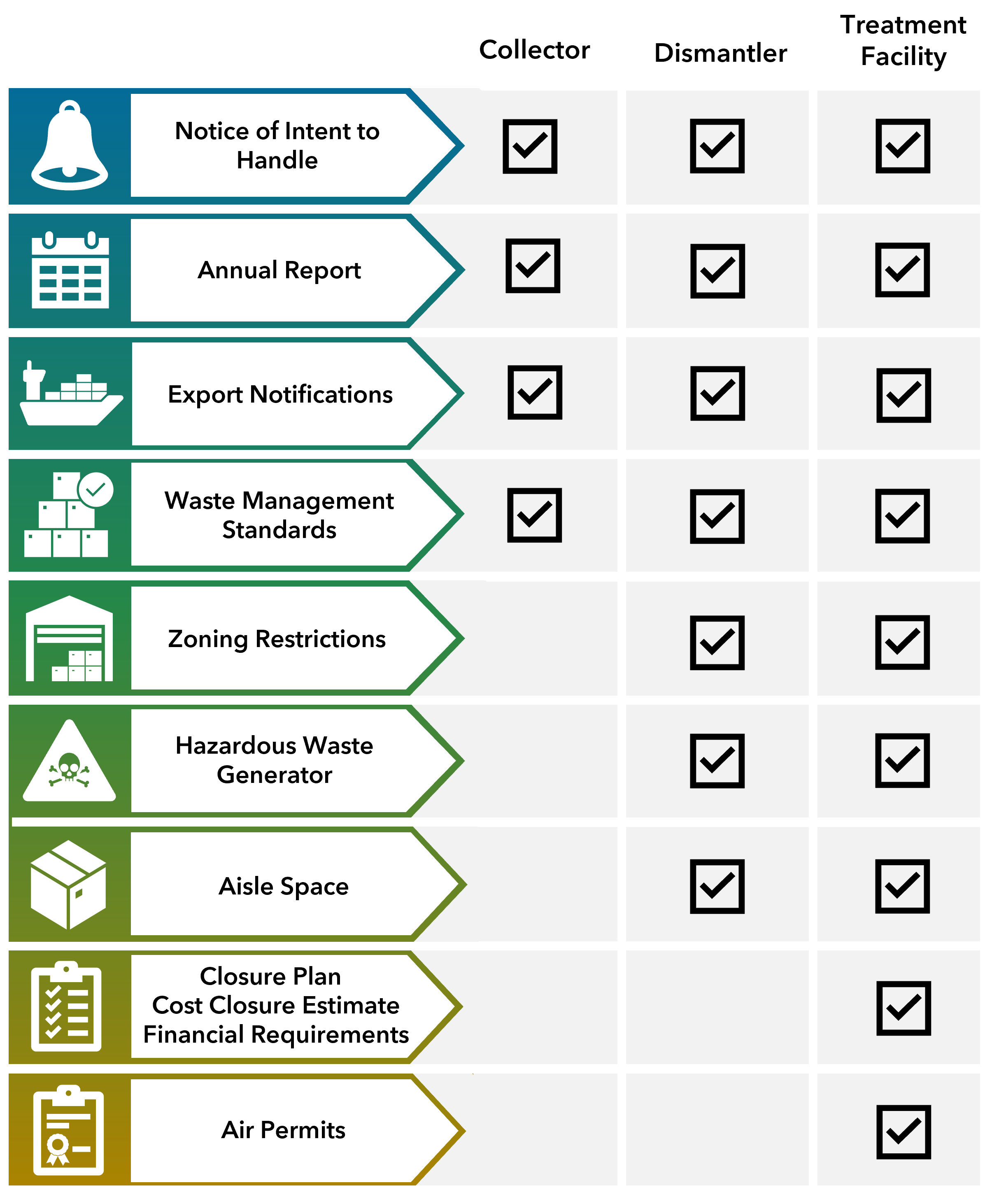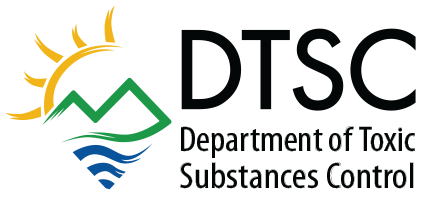E-Waste Home | E- Waste More Information | E-Waste Handler Requirements
Notification of Intent Fact Sheet & FAQs | Annual Report Fact Sheet & FAQs
E-Waste Handler Requirements
Requirements for E-Waste Handlers
Different types of e-waste handlers have different regulatory requirements
Different facility types (i.e., generator, collector, recycler) have different regulatory requirements. To determine what type of facility you operate, consider questions such as:
- How do you plan to operate?
- What activities do you plan to perform?
- Where is the e-waste coming from (on-site versus off-site)?
E-waste handler types
Learn more about what qualifies you as a certain type of e-waste handler.
E-waste generators, collectors, and recyclers are all “universal waste handlers.” You can find the definition of “universal waste handler” in Section 66273.9 of Title 22 of the California Code of Regulations.
E-waste handler requirements
There are four main requirements to consider before becoming an e-waste handler:
Guidance documents
Find guidance for the safe and proper handling of e-waste.
Guidance Documents for E-Waste Handlers
Find guidance for the safe and proper handling of e-waste.
Certain types of handlers may have more requirements to consider. These may include:
- zoning restrictions
- possible hazardous waste generation
- aisle space
- closure plans and cost estimates
- other financial requirements
- air permits

Notification of Intent to Handle
You must submit a one-time Notice of Intent (NOI) to the Department of Toxic Substances Control (DTSC). You must submit the NOI at least 30 days before you begin handling e-waste from off-site. NOIs are required for all collection events.
You must file an NOI for any location where you plan to handle:
- electronic device waste
- bare CRT panels
- CRT glass
E-Waste Notification of Intent Fact Sheet and FAQs
Learn how and when to file a new NOI, including relevant frequently asked questions (FAQs).
Recyclers must provide extra information with their NOI. This may include:
- Providing evidence that the property owner is aware of your recycling activities. This applies if the operator of the facility is not the property owner.
- Additional documentation for treatment facilities including:
- Closure plan
- Closure cost estimate
- Certain financial documents
» Refer to our “Recycling and Treatment of E-waste” document for more information.
Submitting your NOI
You may submit your NOI(s) using either:
Note Recyclers submitting electronically must print out and sign the final signature page. You must mail this signed page to DTSC by certified mail, return receipt requested.

Are you a recycler planning to participate in CalRecycle's Covered Electronic Waste (CEW) Recycling Program?
DTSC must inspect your facility for you to participate in the CEW Program. This inspection ensures you are compliant with California laws and regulations. Every year, we inspect recyclers who continue to participate in the Program. We do not need to inspect collectors in the CEW Program.
That said, all e-waste handlers, including collectors, should be prepared for an inspection at any time.
» To request an inspection, email us at electronicwaste@dtsc.ca.gov.

Are you a recycler planning to participate in CalRecycle's Covered Electronic Waste (CEW) Recycling Program?
DTSC must inspect your facility for you to participate in the CEW Program. This inspection ensures you are compliant with California laws and regulations. Every year, we inspect recyclers who continue to participate in the Program. We do not need to inspect collectors in the CEW Program.
That said, all e-waste handlers, including collectors, should always be prepared for an inspection.
» To request an inspection, email us at electronicwaste@dtsc.ca.gov.
Notifying of facility closure
DTSC aims to maintain an up-to-date record of operating e-waste locations in California. Most e-waste handlers are not required to notify us when an e-waste facility has closed. But, we request that you email us to let us know if and when your business and/or specific facility(ies) closed. Email us to let us know that you would like to close your notification(s).
Once closed, we will no longer contact you about your e-waste handler regulatory requirements, account update requests, and annual reports reminders.
Reasons to close your UWED facility notification(s)
Reasons to close your notifications on UWED may include, but is not limited to:
- Your business closed
- Your facility stopped handling e-waste and you don’t plan to in the future
- You are changing facility types (e.g., you want to start treating the e-waste you receive → recycler)
- You moved to a new authorized location
- You no longer plan to use a notified collection event location
Do you have a notification that you need closed?
In your email, please include:
- the facility ID;
- the reason for closure (e.g., your facility is closed; you no longer handle e-waste);
- when you stopped handling e-waste at the facility.
Waste management
All e-waste handlers must be compliant with all universal waste management regulations. These regulations specify what activities e-waste handlers can and can not do.
The regulations specify the requirements for:

Do I have to provide my personnel with written training on managing electronic devices (EDs) and ED dismantling?
Yes. You must provide all personnel with:
- an initial training
- annual refresher trainings
- written training materials

Do I have to provide my personnel with written training on managing electronic devices (EDs) and ED dismantling?
Yes.
E-waste handlers must provide all personnel with:
- an initial training and
- annual refresher trainings.
Personnel includes everyone who manages, or supervises those who manage, EDs. You must also provide written training materials. For example, you may provide brochures, emails, company letters, pamphlets, and posters.
These training materials must include:
- types of EDs handled at your facility;
- potential hazards of the EDs handled by the personnel;
- proper ED handling techniques; and
- procedures for responding to a release (e.g., waste spill).
DTSC cannot recommend, endorse, or provide training material for you to include in your facility training content. All e-waste facilities are different and handle various types of EDs.
- For detailed training material requirements, refer to California Code of Regulations, title 22, section 66273.36.
Personnel includes everyone who manages, or supervises those who manage, EDs. Written training materials may include brochures, emails, company letters, pamphlets, and posters.
These training materials must include:
- types of EDs handled at your facility;
- potential hazards of the EDs handled by the personnel;
- proper ED handling techniques; and
- procedures for responding to a release (e.g., waste spill).
DTSC cannot recommend, endorse, or provide training material to include in your training content. All e-waste facilities are different and handle various types of EDs.
- For detailed training requirements, refer to section 66273.36 of the California Code of Regulations.
Notifying DTSC of the unintentional receipt of hazardous waste that is not universal waste
If you cannot reject a load of hazardous waste back to the company or person dropping it off at the time of drop-off, you must:
- manage it as a hazardous waste (e.g., shipping it off-site to an authorized hazardous waste facility using a hazardous waste manifest); and
- notify DTSC by email of the illegal hazardous waste shipment
Notified e-waste handlers can not accept hazardous wastes that are not universal wastes
Facilities that are self-authorized (i.e., notified) to receive e-waste in California are not allowed to receive hazardous waste that are not universal wastes from off-site. Only properly permitted facilities in California can receive those hazardous wastes from off-site.
We understand that small amounts of other hazardous wastes may be mixed in with a large e-waste shipment. We also know that it may be hard to track down who dropped off the hazardous waste. So, you would not be able to instruct them to take back the shipment. We encourage you to have a complete and thorough load-check program. This will avoid the risk and responsibility involved with receiving non-universal waste hazardous wastes.
- For more information on off-site shipments, refer to section 66273.38 of the California Code of Regulations

Did you receive an illegal hazardous waste shipment?
In your email, please include the:
- Originating Shipper’s Name
- Originating Shipper’s Address
- Originating Shipper’s Telephone Number
The “originating shipper” is the one who sent you the unauthorized load of hazardous waste. In response, we will send you instructions on how to manage the load of hazardous waste.
Preventing violations and fines/penalties
You may avoid the most serious violations, fines, and penalties by notifying us immediately of an illegal shipment. By doing this, you will also be helping to protect the environment.
Additional waste management for recyclers
E-waste recyclers are subject to inspection by DTSC. Recyclers also have additional recordkeeping and treatment standards they must follow.
- Refer to Health and Safety Code, section 25185(a) for these additional management requirements
Below you will find guidance on handling residuals generated from the dismantling and/or treatment of e-waste.
Guidance for managing e-waste treatment residuals
Guidance for Managing LCD Devices and LCD Device UW Lamp Residuals
Guidance for Managing Plasma Panel Glass Treatment Residuals
Annual Report
Annual Reports are due February 1 of each year for all facilities, including collection events. Facilities that are required to file Annual Reports include:
- Generators who generated more than 11,000 pounds of e-waste (which could be approximately 200 CRT devices)
- Collectors who have accepted 220 pounds or more of e-waste from off-site sources (e.g., households, businesses, collection events) but did not perform any treatment
- Recyclers who treated any amount of electronic waste
If you do not meet one or more of these thresholds, you are not required to complete a full Annual Report. But, we ask that you file a “No Annual Report” report under that reporting year. This tells us that your facility location is still in operation. It also demonstrates that you are aware of your regulatory requirements.
Submitting your Annual Reports
You may submit your Annual Reports using either:
Note Recyclers submitting electronically must print out and sign the final signature page. You must mail this signed page to DTSC by certified mail, return receipt requested.
Export requirements
If you plan to export electronic devices, CRTs, and/or CRT glass for recycling at an authorized destination, you must:
- Notify DTSC via one of the methods listed under the “Submitting your Export Notifications” section on this page
- Send a copy of the notification to the Certified Unified Program Agency (CUPA) having jurisdiction over your facility
You must notify at least 60 days in advance of your initial shipment. This notification is valid for a period of twelve (12) months or less.
Submitting your Export Notifications
You may submit your export notifications using either:
Note If you choose to submit electronically, you must print out and sign the final signature page. You must mail this signed page to DTSC by certified mail, return receipt requested.
Additional export notification and documentation requirements
The specific state and federal notification requirements for exporting electronic devices and/or CRT materials depends on:
- What waste is being exported
- What the receiving facility will do with the waste once it reaches its ultimate foreign destination (i.e., reuse or recycling).
If you are exporting CRT materials
You may need to notify the U.S. Environmental Protection Agency (US EPA). You will file this notification through RCRAInfo WEITS pursuant to 40 CFR § 261.39. You must send a copy of this notification to DTSC at the address provided on this page under “Exporting Covered Electronic Devices (CEDs).”
If you are exporting covered electronic devices (CEDs)
You may need to provide additional demonstration documents. We describe these documents under the “Exporting Covered Electronic Devices (CEDs)” section. Also refer to section 42476.5 of the Public Resources Code for these requirements.
The summary tables under “Exports for Recycling and Reuse” may help you determine which set(s) of requirements apply to your situation. These tables are not intended to be a comprehensive reference. They are also not meant to replace the laws and regulations for exports. Always refer to the regulations provided on the DTSC Laws & Regulations webpage.
Exports for reuse and recycling
Exporting Covered Electronic Devices (CEDs)
If you are exporting CEDs for recycling, you must submit the following information along with your export notification:
- Describe the destination, disposition, contents, and volume of the waste, or device intended for recycling or disposal to be exported.
- Demonstrate that the waste or device is being exported for the purposes of recycling or disposal.
- Demonstrate that the importation of the waste or device is not prohibited by an applicable law in the state or country of destination and that any import will be conducted in accordance with all applicable laws. Apart of this demonstration, required import and operating licenses, permits, or other appropriate authorization documents shall be forwarded to the Department.
- Demonstrate that the waste or device is in accordance with applicable United States or applicable international law.
- Demonstrate that the waste or device will be managed within the country of destination only at facilities whose operations meet or exceed the binding decisions and implementing guidelines of the Organization for Economic Cooperation and Development (OECD) for the environmentally sound management of the waste or device being exported. This demonstration applies to any country of destination, notwithstanding that the country is not a member of the OECD.
- Demonstrate that the person attempted to locate an in-state covered electronic waste recycler and that the waste or device could not be managed by an in-state covered electronic waste recycler.
You must provide DTSC with this information at least 60 days before you begin exporting. For more information, refer to our Export Requirements for Covered Electronic Devices guidance document.
Where do I send these demonstration documents?
You may mail your demonstration documents along with either:
- your signed signature page if you filed your export notification on UWED or
- your completed hardcopy export notification form.
Notifications and signatures pages must be mail by certified mail, return receipt requested, to:
Department of Toxic Substances Control
Universal Waste Notification and Reporting Staff
P.O. Box 806
Sacramento, CA 95812-0806
Attn: Notification to Export Electronic Devices, CRTs, and/or CRT Glass
Forms for e-waste handlers
We recommend submitting all notifications and reports electronically. You may use our online Universal Waste Electronic Devices (UWED) System. But, if you are unable to submit through UWED, you may use the following forms:
- Notice of Intent to Handle: DTSC Form 1388
- Annual Report: DTSC Form 1471
- Export Notification: DTSC Form 1478
All e-waste handlers may use these forms when submitting via hard copy.
Relevant regulations
We are providing these resources for your convenience. This is not meant to be a complete list of universal waste requirements. Universal waste handlers must follow all applicable laws and regulations.
PRC = California Public Resources Code
HSC = California Health and Safety Code
CCR = California Code of Regulations
CFR = Code of Federal Regulations
| Required Documentation | Relevant Regulation(s) |
|---|---|
| Notification of Intent (NOI) | CCR § 66273.32(c) CCR § 66273.74(b) |
| Proof of notifying the property owner of recycling activities | CCR § 66273.74(a)(1)(J) |
| Closure plan | CCR § 66273.76(a)(1) |
| Closure cost estimate | CCR § 66273.76(b)(1) |
| Demonstration of financial responsibility and financial assurance | CCR § 66273.76(c) CCR § 66273.76(d) |
| Notification of closure | CCR § 66273.77 |
| Content Description | Relevant Regulation(s) |
|---|---|
| Authorized e-waste handling and recycling activities | CCR § 66273.71 CCR § 66273.72 CCR § 66273.73 |
| Managing e-waste | CCR § 66273.33.5 |
| E-waste accumulation | CCR § 66273.35 |
| Training personnel who handle e-waste | CCR § 66273.36 |
| Recordkeeping and tracking | CCR § 66273.39 CCR § 66273.74 |
| Labeling of containers | CCR § 66273.34 |
| Additional treatment standards for e-waste recyclers | CCR § 66273.75 |
| Content Description | Relevant Regulations |
|---|---|
| Requirements for annual reporting | CCR § 66273.32 CCR § 66273.74 |
| Content Description | Relevant Regulations |
|---|---|
| Definition of CRT glass | CCR § 66273.9 |
| Definition of CRT glass manufacturer | 40 CFR § 261.39 (a)(5) |
| Additional information required for covered electronic devices (CEDs) | PRC § 42476.5 |
| Notification requirements for recycling used, intact or broken CRTs | 40 CFR § 261.39 (a)(5) CCR § 66273.40 |
| Notification requirements for reusing used, intact CRTs | 40 CFR § 261.41 CCR § 66273.40 |
| Requirement to send DTSC a copy of the US EPA Acknowledgement of Consent within 30 days of receipt | CCR § 66273.40 (b) |
Questions? Contact us at electronicwaste@dtsc.ca.gov
Last updated: August 2, 2024
Universal Waste Links
Hazardous Waste Links
- Hazardous Waste Home
- Certified Appliance Recycler (CAR) Program
- CUPAs
- Defining Hazardous Waste
- Electronic Waste (E-Waste)
- Enforcement and Emergency Response Division
- Facilities (TSDFs)
- Generator Improvements Rule
- Generators
- Hazardous Waste ID Numbers
- Hazardous Waste Management Plan
- Hazardous Waste Manifests
- Hazardous Waste Tracking System
- Household Hazardous Waste
- Metal Recycling
- Metal Shredding Facilities and Wastes
- Permitting
- Toxics in Products
- Transporters
- Universal Waste
- Form 1358
- California Hazardous Waste Codes
Hazardous Waste Related Links
- Annual/Biennial Reports
- Annual Fee Summary
- Customer Billing Portal (Cost Recovery)
- DTSC Advisory on the Management of Spent Fuels
- EnviroStor
- Hazardous Waste Publications
- Find a Registered Hazardous Waste Transporter
- Hazardous Waste Policies & Procedures
- Hazardous Waste Project Documents
- Imports and Exports of Hazardous Waste
- Kettleman Hills Facility
- Land Use Restriction Sites
- Office of Criminal Investigations
- PV Modules (Solar Panels)
- Regulatory Assistance Office
- Report an Environmental Concern
- Retail Waste





